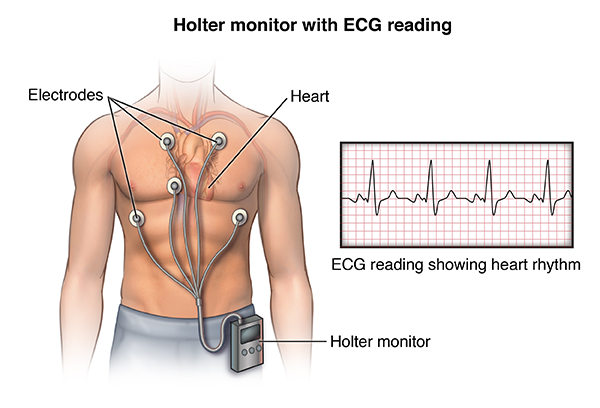
A Holter monitor is a type of portable electrocardiogram (ECG). It records the electrical activity of the heart over 24 hours or longer while you are away from your healthcare provider's office.
A standard or resting ECG is one of the simplest and fastest tests used to check the heart. Small, plastic patches (electrodes) are put on certain points on the chest and belly (abdomen). The electrodes are connected to an ECG machine by wires. The electrical activity of the heart can be measured, recorded, and printed. No electricity is sent into the body.
Natural electrical impulses help control the different parts of the heart. This keeps blood flowing the way it should. An ECG records these impulses to show how fast the heart is beating. It also checks the rhythm of the heartbeats (steady or irregular). It records the strength and timing of the electrical impulses. Changes in an ECG can be a sign of many heart-related conditions.

Your healthcare provider may request a Holter monitor ECG if you have symptoms such as dizziness, fainting, and low blood pressure. They may also request a Holter monitor if you have ongoing tiredness, palpitations, or a resting ECG doesn’t show a clear cause. A Holter monitor may also be ordered if your resting ECG shows a problem but more information is needed. You wear the same kind of ECG electrode patches on your chest and the electrodes are connected by wires to a small monitor box (portable recording device). Newer devices don't use electrode patches and wires. They are a single unit that attaches to the chest like a patch.
Certain abnormal heart rhythms may happen only now and then. Or they may happen only under certain conditions, such as stress or activity. These are hard to record on an ECG done in the office. Because of this, the healthcare provider might request a Holter monitor to get a better chance of catching any abnormal heartbeats or rhythms that may be causing the symptoms. Some Holter monitors also have an event monitor feature that you activate when you notice symptoms. Holter monitors record every single heartbeat and can give information on the minimum, maximum, and average heart rate.
You will get instructions on how long you will need to wear the monitor (usually 24 to 48 hours but sometimes longer). Your provider will also tell you how to keep a diary of your activities and symptoms during the test, and about any personal care and activity instructions. For instance, you will need to keep the device dry while you are wearing it if wires are used.
Some reasons your healthcare provider may ask for a Holter monitor recording or event monitor recording include:
Your healthcare provider may have other reasons to advise a Holter monitor.
The Holter monitor is an easy way to check the heart’s function. Risks of a Holter monitor are minimal and rare.
It can be hard to keep the electrodes stuck to your skin. Extra tape may be needed. It may be uncomfortable when the sticky electrodes and tape are taken off. If the electrodes are on for a long time, they may cause skin irritation or blistering.
There may be other risks depending on your specific health condition. Talk to your healthcare provider about any concerns before wearing the monitor.
Some factors or conditions may affect the results of the Holter monitor reading. These include:
A Holter monitor recording is often done on an outpatient basis. Procedures may be different depending on your condition and your healthcare provider's practice.
Generally, a Holter monitor recording follows this process:
You should be able to go back your normal diet and activities unless your healthcare provider advises differently.
Usually, there is no special care after a Holter monitor recording.
Tell your healthcare provider if you have any symptoms you had before the recording. For instance, if you have chest pain, shortness of breath, dizziness, or fainting.
Before you agree to the test or the procedure make sure you know: